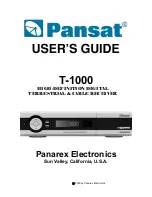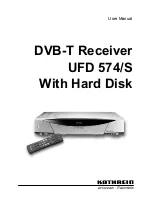
Link XP L2102/L2104 Receiver Instruction Manual Issue 1 - October 2003 Page 21 of 48
Link Research Ltd. 23/24 Watford Metro Centre, Dwight Road, Watford, Hertfordshire, WD18 9XA, England. Tel: +44 (0) 1923 200 900
Registered in London No. 2074604
Web:
www.linkres.co.uk Fax: +44 (0) 1923 241 357
L2102 & L2104 Receiver
Instruction Manual
Section 2 – More Advanced
Operation
2.1
Antennas
A good understanding of how antennas work and their limitations is necessary to maximise
the performance of the LinkXP L2102/2104 receivers. The COFDM modulation method used
has a big advantage of being immune to multipath propagation. As a result the antenna
requirements are very different to those for analogue systems which rely heavily on
directional antennas to get good performance. The following section gives some good
background information with some practical examples of antenna setup.
2.1.1 The
receive
antenna
The requirements for the receive antenna are rather difficult. Normally these antennas
will be located on the edge of the area of activity and will “look” inwards. It is therefore
advantageous if their performance can take advantage of this by only taking signals from
their “front”. In analogue systems this can be done by building Yagi arrays or using horn
type antennas that are very directional and give good performance because they reduce the
effect of multiple path signals by eliminating them. If the transmitter is moving, there
must be an operator to steer the receive antenna so that it tracks the transmitter
accurately. Any mismatch between the paths will result in complete signal loss or partial
break-up of the picture if the signal is on the beam margin. In reality, there are probably
several hundred reflected signals that result in nulls in the received signals.
In a digital system, especially a system using COFDM, much of the performance gain comes
from using multipath reception. As a result there is no need for an operator to track the
transmitter: a fixed antenna works as well because the receiver uses the multipart or
reflected propagation to rebuild the signal.
Transmitter
Receiver
Reflective
object
Reflective object
Direct signal
Reflected signals
Reflctive ogject
Reflected signal
Multipath null
Figure 26 – multipath signals and the null zone
The vertical beamwidth of the receive antenna needs to be fairly high and for a football or
sports stadium, 80º will be very effective. If this can be combined with a horizontal
















































